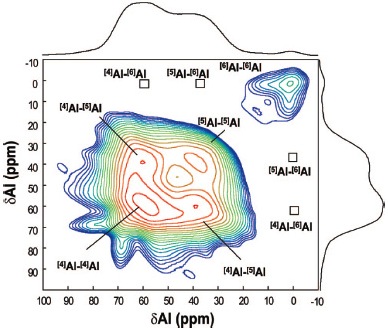Ask for a reprint
email :
* Give your email
2009
ACL
|
S.K.Lee, M.Deschamps, J.Hiet, D.Massiot, S.Y.Park, 'Connectivity and proximity between quadrupolar nuclides in oxide glasses: Insights from through-bond and through-space correlations in solid-state NMR', J. Phys. Chem. B 113 5162-5167 (2009) doi:10.1021/jp810667e
The connectivity and proximity among framework cations and anions in covalent oxide glasses yields unique information whereby their various transport and thermodynamic properties can be predicted. Recent developments and advances in the reconstruction of anisotropic spin interactions among quadrupolar nuclides (spin > ½) in solid-state NMR shed light on a new opportunity to explore local connectivity and proximity in amorphous solids. Here, we report the 2D through-bond (J-coupling) and through-space (dipolar coupling) correlation NMR spectra for oxide glasses where previously unknown structural details about the connectivity and proximity among quadrupolar nuclides (27Al, 17O) are determined. Non-bridging oxygen peaks in Ca-aluminosilicate glasses with distinct connectivity, such as Ca-O-Al and Al-O-Al, are well distinguished in 27Al-17O solid HMQC NMR spectra. Both peaks shift to a lower frequency in direct and indirect dimensions upon the addition of Si to the Ca-aluminate glasses. The 2D 27Al double quantum MAS NMR spectra for Mg-aluminoborate glasses indicate the preferential proximity between [4]Al and [5]Al leading to the formation of correlations peaks such as [4]Al-[4]Al, [4]Al-[5]Al, and [5]Al- [5]Al. A fraction of the [6]Al-[6]Al correlation peak is also noticeable while that of [4,5]Al-[6]Al is missing. These results suggest that [6]Al is likely to be isolated from the [4]Al and [5]Al species, forming [6]Al clusters. The experimental realization of through-bond and through-space correlations among quadrupolar nuclides in amorphous materials suggests a significant deviation from the random distribution among framework cations, and a spatial heterogeneity due to possible clustering of framework cations in the model aluminoborate glasses.
|

|